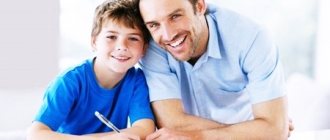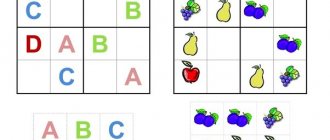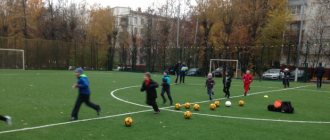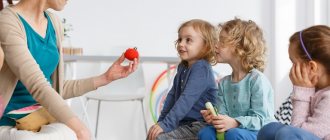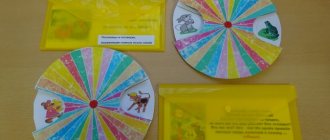5-7 years, or senior preschool age, is an important period in the personal and psychological development of a child, as well as in the development of thinking, will, and attention. This is the so-called preparatory age, after which the child will move to a new stage - and the crisis of 7 years will begin, characterized by a change in the leading type of activity from play to learning, an increase in independence and social environment.
To help your child go through this stage correctly, you need to know the age characteristics of older preschoolers, the characteristics of this age and areas favorable for development. Don’t forget that your child’s health is the basis of his successful future, so he needs to be helped, and not forced to do and be able to do what he does not yet have the capabilities to do.
Nursery
The youngest pupils are accepted into the nursery group of the kindergarten. Their age ranges from 1 year to 2-3 years. They are usually located on the ground floor; the furniture in the group corresponds to the height of the children.
Classes are provided on the development of speech, music, and the surrounding world, in accordance with the plan. Classes are conducted by a teacher in a group and last no more than 10 minutes.
Toys are also selected according to age: large cubes and pyramids, rubber animals and baby dolls, balls, cars, children's sets for playing with sand, dolls, doll dishes, baby books - all without small and dangerous parts.
The daily routine in the nursery group differs from that of older children: early breakfast, lunch, afternoon snack, dinner. Going to bed early for a quiet hour.
There should be no more than 10-15 children in such a group. The presence of a nanny is required to help dress and undress the children, feed and wash them, and put them to bed.
There is usually only one holiday - New Year, and it is also celebrated in a group.
Short stay group (STG)
As a rule, very young children from 1 to 3 years old are enrolled in the short-stay group. This service can be used by any interested parent who has submitted the necessary documents and joined the queue. Such groups work 3 times a week for 3 hours in total.
Classes there start at 8:30 and last until 11:30. There is also an evening shift from 16:00 to 19:00. It all depends on the schedule of classes at the educational institution, so always check the opening hours at your garden.
Note to parents
Most often, parents worry about at what age to send their child to kindergarten and whether it is worth doing it so early, because children from 1 to 3 years old still need their mother’s presence. It is especially difficult for parents to make a decision if this is the first baby in the family.
Staying in kindergarten is the very first and most important experience for every child. Here he learns to show his personal qualities and communicate with peers.
If we omit the details, the opinion of many experts agree on one thing: from a psychological point of view, meeting and communicating with children in a playful and relaxed manner helps the child adapt and enter society. After all, in this society the child will grow and develop, gain experience and experience different stages of personality development. And the sooner the child begins to adapt, the better it will be for his psychological health.
It should be noted that young mothers and fathers should also be prepared for such a responsible step.
And before you send your child to a short-stay group, make sure that this is exactly the place where your son or daughter will be comfortable.
Today you can quickly find reviews on the Internet about any product or service. Look for reviews and comments about your kindergarten. And you probably know mothers whose children also go to this kindergarten. You can also come to the kindergarten and see everything with your own eyes, and chat with the nannies and teachers.
What activities are conducted with children in short-stay groups?
Typically, such groups have 2 classes a week of physical education and music and once a week classes in drawing, modeling, literature and design.
It’s also not difficult to sign up for GKP groups. They are available in almost all preschool institutions. To be included in the group, you must:
- contact the head of the kindergarten with a request to enroll the child in the GKP. If there are places in the group, you will definitely be accepted;
- if there are no free places, contact the so-called “Mini-OSIP” (this is the district information support service).
- You can also sign up for the group through the city services portal
When you have found a place, you need to worry about documents for the garden. There are not many of them, but you will have to collect them quickly:
- passport of the parent or legal representative of the child;
- baby's birth certificate;
- child registration in the city;
- if you have benefits, also provide a document for inclusion in the preferential category;
Enrollment in the GKP occurs in the same way as in a regular kindergarten group. You are put on a waiting list and when a place becomes available, they call you and inform you that your child can go to kindergarten.
Procedure for enrollment in a short-stay group.
When there are few free places in a group, the head of the kindergarten must follow certain rules when enrolling a child in the group. For example, your child will be accepted faster if:
- your family (or child) lives/is registered in this area;
- preferential categories of children
If all children from this list are enrolled, then in order of priority the following are enrolled:
- children with temporary registration
- kids from other areas
A parent does not have to go to the daycare every week or month to find out if a place has become available. Typically, parents are sent an email notification or receive a call on their cell phone.
When enrolling in kindergarten, check the availability of a medical card, and immediately before enrollment you must provide:
- contacts of the child and his parents;
- complete blood count and urine test;
- analysis for enterobiasis and worm eggs
Before enrolling a child in a kindergarten group, the parent will have to sign a service agreement, which will spell out all the rights and responsibilities of both parents and teachers.
As a rule, documents of this kind protect both parties from possible claims. Therefore, every parent should not be lazy and read this agreement carefully.
Features of children staying in a short-term group
The child is not in kindergarten all day, but only for some part of the day, so meals are not provided here. But any baby can freely ask for water. So before you send your son or daughter to kindergarten, don't forget to feed him.
Adaptation in the group is quite smooth. Any parent can go to the group and see how their child feels there. This makes it easier for the baby to survive a long separation from his parents and get comfortable in a new environment. Remember also that the child’s psyche is quite vulnerable at this age, and any innovation can have a bad effect on his emotional state. But if you prepare your baby and send him to a short-term group, you can avoid negative emotions on the part of the baby.
The first days in the GKP last only half an hour for a child. Then the stay time becomes longer, but it all depends on the child’s behavior and addiction. Often educators recommend starting with half an hour and adding only 15 minutes every few days so as not to escalate the situation.
Approximate schedule for short-stay groups:
- Monday - 9:00-9:10 music games; 10:10-10:20 didactic games;
- Tuesday—10:00-10:10 movement development, 10:30-10:40—artistic creativity (drawing, modeling, appliqué, coloring must alternate here);
- Wednesday—9:00-9:10 didactic game, 10:00-10:10 speech development;
- Thursday—9:00-9:10 outdoor game; 10:00-10:10 games with building materials;
- Friday—9:10-9:20 educational game; 10:00-10:10 music game
The average monthly cost of GKP is about 1,500 rubles. However, if you have benefits, you can write an application for payment compensation (or part of the compensation).
What additional expenses does the parent expect?
Many kindergartens and groups also have additional expenses, which most often depend on the director of the kindergarten. This point should also be discussed in advance, and it is best to do this at the time of signing the contract with the garden. Although, the times when huge gatherings were held in gardens are long gone.
However, some parents face actual extortion. In this case, you should contact the anti-corruption hotline.
Junior
The younger group is attended by children aged 3 to 4 years. These are more independent children who know and can do a lot.
Drawing, physical education and music lessons with specialist teachers, drawing and modeling are added to the main classes. The duration of the lesson is 15 minutes.
Children at this age love to play role-playing games, so among the toys there are various, but simple, children's sets of a doctor, a hairdresser, a builder, a cook, as well as all kinds of construction sets with large parts and figures.
Reading books may contain a longer and more detailed plot. There should also be books with riddles and simple coloring books with a simple silhouette or outline.
In the younger group, in addition to the New Year, a holiday dedicated to March 8 is often organized for children, and they are held in a large music hall.
Many children at this age already speak well, so for performances at holidays they can be given poems and small roles to memorize together with their parents.
Average
The age of children in the middle group is from 4 to 5 years. They are already more physically developed, love to play outdoor games, and acquire the first skills in using simple sports equipment (balls, hoops, skittles, gymnastic sticks, etc.). Therefore, in the middle group of kindergarten they conduct much more physical education classes and physical education minutes, including outside.
Classes such as mathematics, literacy, application, and logic are being introduced. Class duration is 20 minutes.
In many kindergartens, parents are given the opportunity to enroll their children in additional clubs - dance, English, arts and crafts, etc.
Toys and games include cubes with complex patterns for making pictures, lotto and dominoes, educational board games, as well as glove toys for acting out theatrical scenes and fairy tales. Children can now not only listen to a fairy tale to the end, but also, having memorized the roles, show it to children of younger groups.
“Autumn Festival” and “Spring Festival” are added to the main matinees.
What areas are actively developing?
The developmental features of children aged 5-7 years are also determined by the sensitive – that is, the most favorable – period for the formation of personality and social skills. The foundation for the child’s future personality is already being laid.
There is an interest in group games and a desire to be good, the best, the first. This is a positive attitude that is based on a motive for any activity. The child begins to understand: in order to win, you need to take certain actions, make an effort, and not just cry.
Moral and ethical guidelines are formed: what cannot be done, and what can be done, or what is allowed to be done with one’s own toys and things, but not with other people’s. Personal boundaries are drawn up: “You don’t need to yell at me. I don't want to be yelled at. Why can’t I yell at you, but you yell at me?” There is a need for approval and respect from others, a desire to be useful: “I will help you. I'll bring the package."
Children of older preschool age learn to restrain their desires and needs, and understand that not everything can be obtained right now. If the child is explained, he will understand that he needs to wait until his mother finishes cleaning, and then he can go for a walk. The child begins to realize the consequences of his actions: if you haven’t collected your toys, you won’t be able to play with them until the evening.
The image of your “I” is formed. The older preschooler begins to realize what place he occupies in society, in the family (there are adults and there are children), what attitude others have towards him (“Mom and Dad love and protect me”). The child also begins to evaluate himself (I am good, smart, kind). An image of the “ideal self” is emerging, i.e. what the baby would like to be. Most often, he focuses on the closest adults: he wants to be strong, like dad, beautiful, like mom. It is important to maintain this ideal image and transform it into the “Real Me”. Tell your child: “You are strong!” or “You are very beautiful.”
It should be taken into account that at 5 years old a child’s self-esteem is inflated, but closer to 7 years old it becomes more realistic. By this moment, he has already sufficiently developed the ability for introspection, therefore, in familiar situations he evaluates himself normally, but in unusual ones he exceeds his capabilities, since he has not yet developed a mental model of an ideal result. Low self-esteem in a child is a pathology! A consultation with a psychologist is definitely needed in such a situation.
In older preschool age, visual-figurative thinking continues to develop and the foundations of abstract-logical thinking are laid. Sometimes the baby still needs to act with objects, especially unfamiliar ones, in order to understand their purpose, but he is increasingly operating with mental images.
Older preschool children are actively developing attention, memory and the ability to consciously concentrate on any activity. Perseverance is formed, which is a necessary skill when the child goes to school and switches to educational activities. You can read more about sensitive periods of development of certain areas in the article “Sensitive periods”.
Older
The senior group of the kindergarten is attended by children aged 5 to 6 years. Classes are already becoming more intense, in-depth and longer – 25 minutes each.
In addition to the basic ones, classes can be held on the history of the native land and basic handicraft skills can be instilled.
Children can already perform simple exercises from sports such as gymnastics, basketball and some others.
The toys in the group should be varied and age-appropriate: mosaics, puzzles, three-dimensional construction sets with many details.
Children are also taught housekeeping skills. Therefore, among the toys there should be miniature doll gas stoves, cutlery, an ironing board with a toy iron, brooms, dustpans and brooms. You can invite children to care for indoor flowers, aquarium fish, and parrots.
“Christmas”, “Defender of the Fatherland Day”, “Easter”, “Victory Day” are added to holidays and matinees.
Preparatory
The preparatory group of the kindergarten is attended by children aged 6 to 7 years. For children, this is a very important, last, final stage before entering school.
There are many developmental and educational activities: reading and mathematics, native speech and the world around us, music and physical education, manual labor and origami, modeling and drawing.
The group often sets up easels and hangers with clothes from various professions for children’s story games. At this age, children are actively learning the rules of etiquette, as well as traffic rules.
Matinees and holidays are elaborate and theatrical. Children can even act as presenters. The graduation party at the end of the year is the most important for children and their parents, where graduates show all their abilities and talents.
Summary of the parent meeting Topic: “Senior preschool age, what is it like?”
MUNICIPAL BUDGETARY PRESCHOOL EDUCATIONAL INSTITUTION
"KINDERGARTEN No. 37 "ROSINKA" VORKUTA
Parent meeting in the senior group "Rosinka"
Topic: “Senior preschool age, what is it like?”
Participants: Teachers, parents.
Yashchenko Elena Mikhailovna
Educator
October 2022
Parent meeting in the senior group "Rosinka"
Topic: “Senior preschool age, what is it like?”
Purpose: To familiarize parents of pupils with the age characteristics of children in the senior group.
Objectives: Consider the age characteristics of children 5–6 years old, introduce parents to the educational process in the older group. Promote the emotional rapprochement of all participants in the educational process and organize their communication.
Meeting plan:
1. Introductory part.
2. Speech by the head “Comprehensive safety of preschool educational institutions. Registration of compensation for part of the parental payment for childcare and supervision.”
3. Age characteristics of children 5-6 years old.
4. Familiarization of parents with the educational process in the senior group.
5. Game “Color the flower”
6. Briefly about miscellaneous things.
7. Selection of the parent committee.
8. Final part.
Progress:
Introductory part.
Educator: Good evening, dear parents! We are very pleased to see you at the meeting today. We will begin our meeting with the selection of a secretary.
New children have joined our group - let's get to know each other. (Welcome and introduction to parents of new children). This is how we met.
The manager came to meet us. We give her the floor.
Speech by the head on the topic: “Comprehensive safety of preschool educational institutions. Registration of compensation for part of the parental payment for childcare and supervision.”
Speech on the topic: “Age characteristics of children 5-6 years old.”
Each child develops in his own way, each has his own path and pace of development.
We present to your attention a general age portrait of a 5-6 year old child, with indicators of different aspects of his development.
Age 5 - 6 years is the senior preschool age. It is a very important age in the development of the child’s cognitive sphere, intellectual and personal.
At 5-6 years old, a child absorbs all cognitive information like a sponge. It has been scientifically proven that a child at this age remembers as much material as he will never remember later in his life. At this age, the child is interested in everything related to the world around him and expanding his horizons. The best way to get scientific information is to read a children's encyclopedia, which clearly, scientifically, in accessible language describes to the child any information about the world around him. The child will gain an understanding of space, the ancient world, the human body, animals and plants, countries, inventions and much more.
This period is called sensitive, i.e. most favorable for the development of all cognitive processes: attention, perception, thinking, memory, imagination. To develop all these aspects, the game material becomes more complex, it becomes logical, intellectual, when the child has to think and reason.
It is good at this age to play word games with the child, since the child already uses synonyms and antonyms in his speech, distinguishes between vowels and consonants, and can determine the number of syllables in words, the place of the sound in the word (beginning, middle, end of the word).
The designer develops logical thinking well. The important point here is folding according to a pattern - a pattern, starting with simple patterns. Cubes, various puzzles, mosaics must be laid out according to the picture, focusing on color, shape, size.
Various logical tables develop all analyzers - visual, logical, verbal. For example, the game “Odd Four” - the pictures show various objects. Of the four items, one is extra. The child must think and choose this extra item and say why it is extra. Game "Place in order." A series of illustrations are offered, related to the same theme, but laid out incorrectly. The child must determine which of the illustrations depicts what happened earlier or later - that is, put it in order. Here the child must see the sequence, trace the logical pattern and justify it.
At the age of five, cognitive and intellectual spheres actively develop. And the better developed attention, perception, thinking, memory, imagination, the better and faster the child develops, the better prepared he is for school.
Speech on the topic: Introducing parents to the educational process in the senior group.
We would like to remind you that we are now the senior group. Our daily routine, hours and number of classes per day have changed. Now each lesson lasts 25 minutes and there are 12 lessons per week.
Your children have gotten older, and as a result, their responsibilities have increased. Both the program and teaching methods acquire the character of educational activity.
In order for the educational process to be properly organized, in our work we rely on the main regulatory documents regulating the activities of preschool educational institutions:
- The federal law ;
- Federal State Educational Standard for Preschool Education;
- SanPin 2.4. 1. 2660-10.
- International Convention on the Rights of the Child.
We work according to the preschool education program “From birth to school” edited by Veraksa N.E., Vasilyeva T.S., Komarova M.A.
We prepare children for school, develop perseverance, curiosity, attention, and memory. And it is the joint work of us teachers and you, parents, that can give a positive result.
We would like to introduce you to what children should know by the end of the school year.
Cognitive development:
Formation of elementary mathematical concepts.
By the end of the school year, children should be able to count objects within 10. Be able to indicate the number of objects with the corresponding number.
Be able to divide a square into 4 equal parts and name the parts.
Be able to navigate on a sheet of paper, determine the sides, corners and middle of the sheet.
Be able to distinguish and name flat and three-dimensional geometric shapes (circle, square, triangle, rectangle, ball, cube, cylinder).
Be able to consistently name the days of the week, determine what day of the week is today, what it was yesterday, what it will be tomorrow.
Familiarization with the social and objective world:
Have some ideas about educational institutions (school, kindergarten, college, university, etc.).
Have ideas about professions.
Have an idea of how seasonal changes affect people's lives and work.
Have primary ideas about the diversity of peoples of the world, races, nationalities.
Classify and compare objects by purpose, color, material, shape.
Distinguish and name types of transport.
Getting to know the natural world around you:
Have an understanding of living and inanimate nature, seasonal changes in it and human activities. About plants, mushrooms, animals, as representatives of living things in the natural world, their basic life functions and needs, and habitat. About natural communities of animals and plants, their relationships and features of adaptation to the environment and seasonal changes in it.
Speech development:
Use all parts of speech, actively engage in word creation, use synonyms and antonyms.
Choose several adjectives for the noun; replace a word with another word with a similar meaning.
Determine the place of a sound in a word, divide the word into syllables, count the letters in a word, come up with a word starting with a given letter.
Share various impressions with the teacher and other children, refer to the source of the information received (TV show, story of a loved one, visiting an exhibition, children's play, etc.).
Make up your own short story on a given topic.
Have a fairly large vocabulary.
Participate in the conversation and express your opinion.
Compose stories based on a plot picture, based on a set of pictures; consistently, without significant omissions, retell short literary works.
Retell short tales and stories coherently, consistently and expressively.
Artistic and aesthetic development:
In drawing:
Create images of objects (from life, from an idea), plot images.
Use a variety of compositional solutions and visual materials. Know the features of visual materials.
Use different colors and shades to create expressive images.
Make patterns based on folk arts and crafts.
In sculpting:
Sculpt objects of different shapes using learned techniques and methods of sculpting.
Create small plot compositions, conveying proportions, poses and movements of figures.
Create images based on folk toys.
In the application:
Depict objects and create simple plot compositions using a variety of cutting techniques and tearing paper.
In design:
Design according to your own ideas.
Analyze a sample building.
Plan the stages of creating your own building, find constructive solutions.
Create buildings according to a drawing or diagram.
In music:
Distinguish between genres of musical works (march, dance, song); sound of musical instruments (piano, violin).
Distinguish between high and low sounds.
Sing without tension, smoothly, with a light sound; pronounce words clearly, start and finish the song in a timely manner; sing accompanied by a musical instrument.
Move rhythmically in accordance with the character and dynamics of the music.
Perform dance moves.
Social and communicative development:
Development of gaming activities:
Agree with partners on what to play, who will be who in the game; obey the rules of the game, develop the content of the game depending on the number of children playing, explain the rules of the game to peers. Accompany game interaction with speech. Resolve controversial issues and resolve conflicts in the game with the help of speech: convince, prove, explain. In games, evaluate opportunities and accept loss without resentment.
Self-care skills:
Possess basic self-care skills: dress and undress independently, dry wet things, keep your closet in order; use cutlery (spoon, fork, knife) correctly.
Introduction to work:
Responsibly perform the duties of a dining room attendant and set the table correctly. Participate in maintaining order in the group and on the territory of the kindergarten. Carry out feasible work assignments, understanding the significance of your work, and demonstrate the ability to bring the work started to completion.
Formation of security fundamentals:
Follow the basic rules of safe behavior in kindergarten. Observe basic rules of behavior on the street and in transport, basic traffic rules. Distinguish and name special types of transport (“Ambulance”, “Fire”, “Police”), explain their purpose. Understand the meaning of traffic lights; recognize and name the road signs “Pedestrian crossing”, “Children”, “Tram stop”, “Bus stop”, “Underground pedestrian crossing”, “First aid station”. Distinguish between a roadway, a sidewalk, an underground pedestrian crossing, and a zebra crossing. Observe basic rules of behavior in nature (ways to safely interact with plants and animals, respect for the environment).
Physical development:
Walk and run easily, rhythmically, maintaining correct posture, direction and pace.
Climb the gymnastics wall with changes in tempo.
Jump on a soft surface, long jump from a place, jump over a short and long rope.
Throw objects with the right and left hands at a distance of 5-9 meters, combine a swing with a throw, throw the ball up onto the ground and catch it with one hand, hit the ball on the spot. Form into a column of three or four; align, open in a column, line; make turns right, left, around.
Use physical education equipment outside of class (in your free time).
Educator: We hope that with common efforts we will achieve all this.
Educator: Now let’s rest a little and play a game.
Game "Color the flower"
Educator: Take everything one flower at a time. Color them (there are flowers of the same size, shape, and colored pencils on the tables). Now compare your flower with the flowers of your neighbors. All the flowers were the same in size, color, and shape.
Educator: Tell me, after you have painted a flower, can you find two completely identical flowers? (No). Under the same conditions, we do everything differently.
Hence the rule: Never compare your child with other children! All children are different and adults too. Rejoice in his personal achievements and successes.
Briefly about different things.
Educator: Continuing our meeting, we will talk briefly about different things.
We would like to remind you of the safety rules. About safety measures both in kindergarten and outside. In connection with the current situation regarding coronavirus infection, it is imperative to observe precautionary and preventive measures. In our kindergarten, mandatory disinfection of door handles, handrails, and other surfaces is carried out. Ventilation in the absence of children, quartz treatment. Children must wash their hands. When entering the kindergarten, your temperature is taken. Hands are disinfected. And entrance to the kindergarten is only with a mask.
Also traffic rules. In September, pedestrian collisions increased.
Be careful and careful. Protect yourself and your children. Attach reflective elements to your clothing. So that drivers can see you in the dark. Carrying children in a car must be safe: car seats, seat belts - everything must be in working order. Talk to your children about basic traffic rules, as well as road signs. Do not cross the road with children in unauthorized places, but only at a pedestrian crossing. If your child or you are crossing the road on a bicycle, be sure to dismount and teach your children to do the same.
Fire safety rules. The kindergarten has a fire alarm and we constantly conduct evacuation training. We kindly ask you to talk to your children at home about the rules for using electrical appliances and what to do in case of fire.
And of course, don’t forget about terrorism. Another problem of our society is terrorism. Be vigilant and attentive, do not let strangers into the kindergarten. Find out who they are going to, what group.
In kindergarten we study and repeat these rules, but you also do not forget about them. (Memos for parents)
The main rule of children's safety is our parental example!
Dads and moms - be a worthy example for your children!
We really want to see as many children as possible at morning exercises, because it is very important for children. Promotes awakening of the body, moderately affects the muscular system, stimulates the functioning of internal organs, promotes the formation of correct posture, good gait, prevents the occurrence of flat feet, and energizes the mood.
Do not deprive your child of a good mood, enthusiasm, health and vigor! Bring your children to morning exercises. But if for some reason you are late for the morning
gymnastics and you see that we are not in the group, do not leave the child alone in the group, wait for the teacher.
Educator: Bring physical education uniform to physical education classes: white T-shirt, black shorts, sneakers. The form is stored in a bag in a cabinet. Physical education classes are intense and active, so you need reliable shoes to keep your feet secure - these are sneakers.
Receipts for kindergarten are paid by the 20th of each month. If a child does not attend kindergarten due to illness, parents must collect the receipt and pay for it on time.
Selection of the parent committee.
Educator: Dear parents! At the end of our meeting, let's decide the issue of choosing a parent committee. The selection of the parent meeting is carried out by counting votes and announcing the results.
Final part.
Educator: Our meeting is ending, but I still have a magic chest in my hands
Game "Wish Box"
Educator: I suggest each of you write a wish on paper, what qualities do you want to cultivate in your child? What do you think your child is lacking? Our box is magical! We will try to take into account everything you plan. We will summarize the results at the end of the school year.
We wish you success, patience and hope for mutual understanding.
See you again!
Speech therapy
Children are recruited into speech therapy groups by a speech therapist based on preliminary testing and after a thorough examination. The ONR group includes children with general speech disorders, the FNR group includes children with problems in pronouncing certain sounds.
Pupils, in addition to the main classes, engage in special exercises with a speech therapist and teacher aimed at improving and improving their speech.
In such groups there are usually not many children - 10-12 people. Classes with a speech therapist can be individual or group, and are conducted according to a schedule. All other classes are conducted according to a simplified and facilitated plan, acceptable for children with such defects.
Native speech
In the older group, children usually do not have problems with articulation; they clearly pronounce all the sounds of their native language. They are able to speak coherently and expressively, and are able to control the volume of sound and speed of speech.
In their native language they already have the following knowledge, skills and abilities:
- Knowledge of synonyms, antonyms, pairing words, using phrases of nouns with adjectives.
- Use of simple and complex sentences.
- The use of direct and indirect speech.
- The ability to conduct a dialogue, conversation, answer questions from the teacher and peers.
- Compiling a coherent short story based on the provided sample or plan.
- Determining the genre of the work read.
- Reading large literary works chapter by chapter, restoring what was read from memory.
- Reading by role of various works.
- Knowing several poems by heart.
- Ability to recall read information from memory.
Summer
A summer group is usually a temporary group for the summer period, which is attended by children of different ages. There are usually no classes in the summer, but only outdoor games, reading books, going to puppet theaters or museums.
In any group of a preschool institution there must be two teachers and one nanny.
The day should be organized strictly according to the regime established for each specific age, with games, walks, activities, and entertainment. Each lesson is held no more than 2 times a week.
